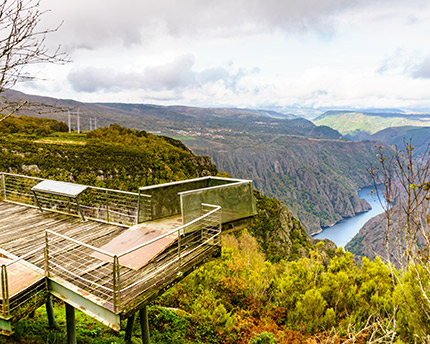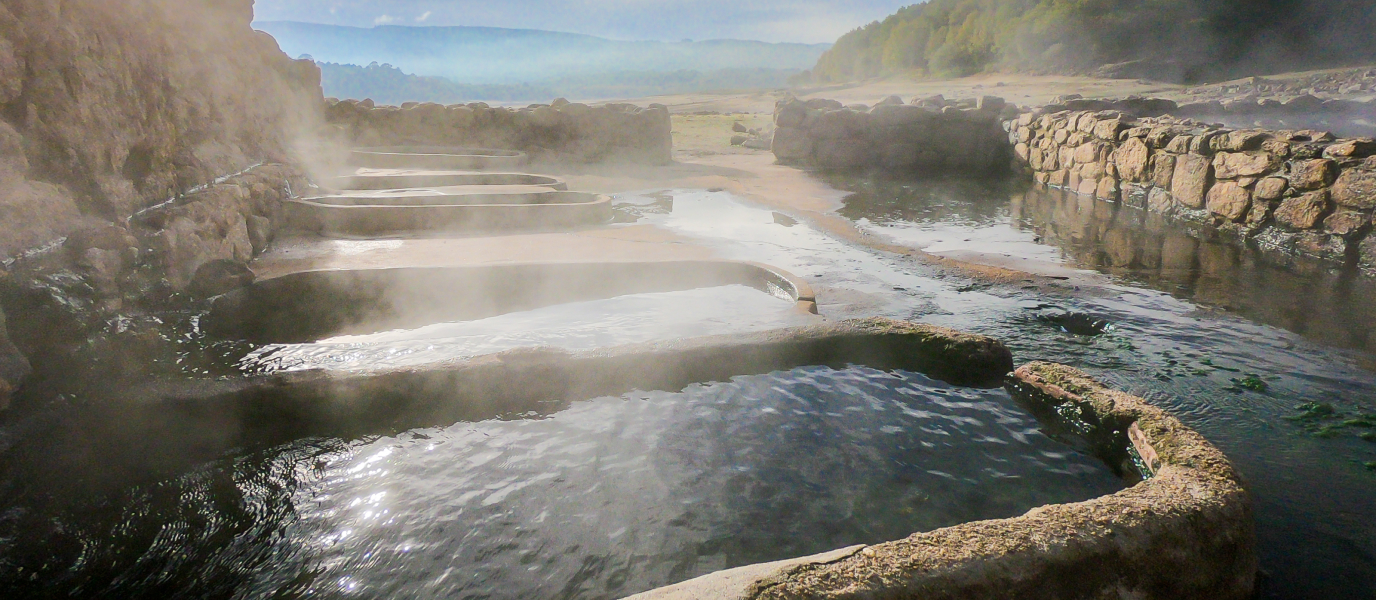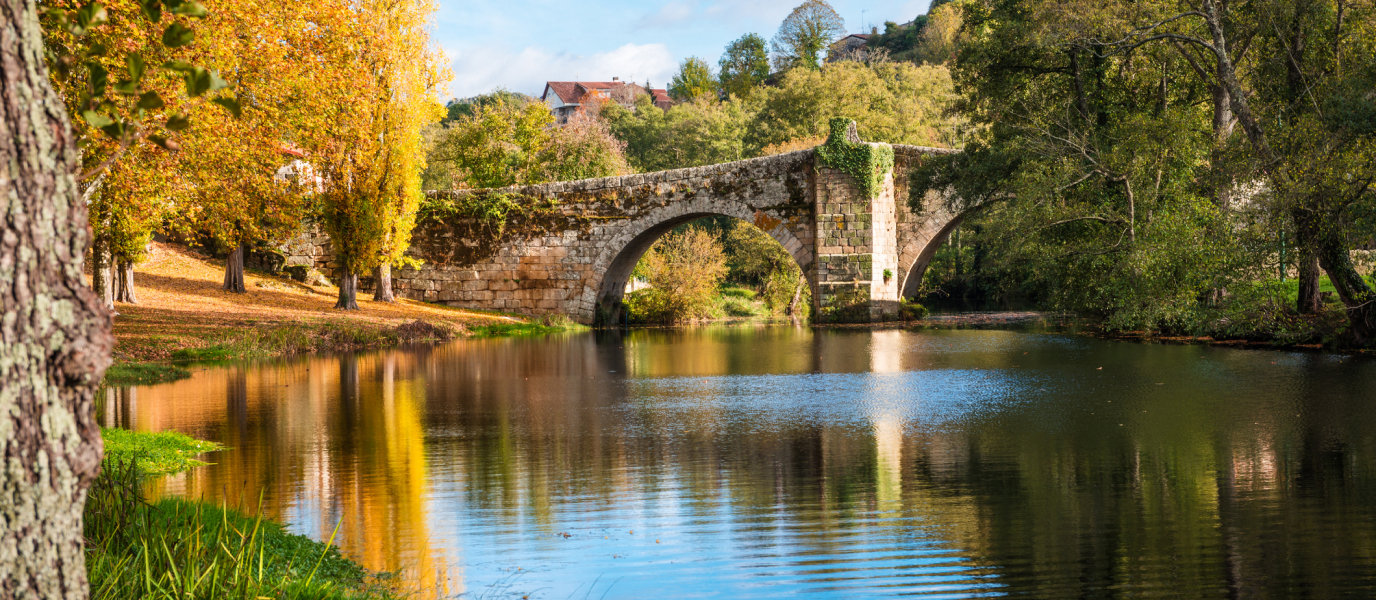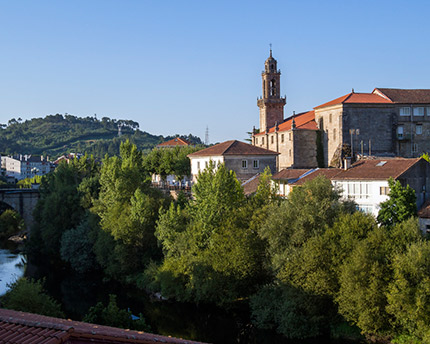Ourense is one of the least-known provinces in Spain but it’s well worth exploring through the history of its medieval villages. Discover castles, legends, towers, sanctuaries, narrow streets, and estates that played a key role in Galicia’s history.
Allariz
The origins of this medieval village can be traced back to Roman times but its name comes from Alaric, King of the Visigoths. It has a unique historic centre with a Roman bridge, stone stairways, noble houses with thick walls and ancient churches with a long history that are Cultural Artistic Heritage sites.
Don’t miss the old convent of Santa Clara, which was founded by Queen Violant, wife of Alfonso X the Wise: its inhabitants are still an enclosed religious order but the Museum of Sacred Art is open to the public. The museum contains a Vierge Ouvrante, a very special type of moveable-part sculpture that dates from the 13th century.
Allariz is also popular because its old town has fashion stores by the leading Galician brands: Maximo Dutti, Zara accessories, Adolfo Domínguez and Roberto Verino, among others.
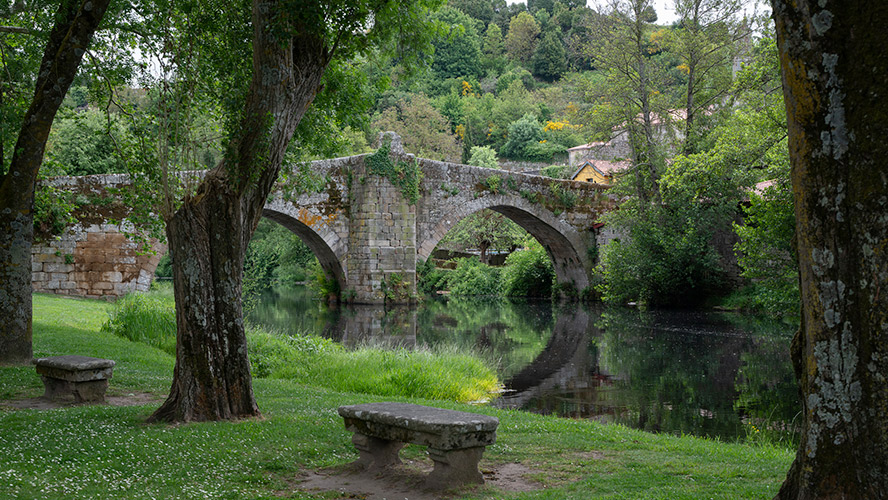
Castro Caldelas
Castro Calderas is the heart of the Ribeira Sacra area and is dominated by an impressive medieval castle that stands above its narrow streets and stone houses. Houses here are famous for their white galleries, a feature typical to the village.
The castle was built in the 13th century by Pedro Fernández de Castro, lord of Lemos y Sarria. In the 18th century, it passed into the hands of the House of Alba, and the family donated it to the village thirty years ago.
The imposing fortress has a double wall and is notable for its towers, particularly the clock tower, although the clock itself is more modern than the stones around it. Part of the castle houses the Archaeology and Ethnography Museum.
You can’t visit Castro Caldelas without taking a stroll around its incredible streets and stopping at the Neoclassical sanctuary of Nuestra Señora de los Remedios, which is much beloved by locals. If you’re firm Galicianists, you’ll be interested to see the “Magistrates’ Monument”, raised in memory of three residents of Casto Caldelas who were the first to use Galician in the Ministry of Justice.
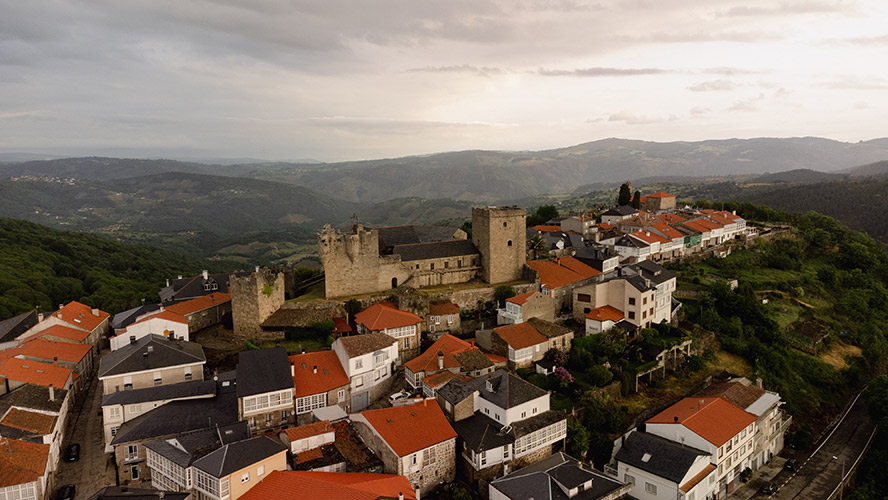
Ribadavia
It’s a little-known fact that this incredible village was the capital of Galicia between 1065 and 1071. Its attractions include a medieval castle, impressive pazos (a type of Galician manor house), houses of the nobility and a thermal baths where you can unwind and de-stress.
The best way to see the village is by wandering the narrow streets of its Jewish quarter and admiring its old stone buildings; many Jews settled here to trade wine, export goods to Europe or become artisans. Logically, the Jewish Information Centre of Galicia is based here.
Another important sight in Ribadavia is the castle of the Counts of Sarmiento, a series of ruins that still have a great sense of character, particularly the walls. The Ribadavia International Theatre Festival is held here, one of the most important events in Galicia.
Particularly distinctive features of the village are its pazos and the wonderful viewpoints all around. A walk around the outskirts quickly reveals old palatial houses, such as the Casa do Carballo, and the House of the Inquisition is inside the village. Go a little further and climb up to a viewpoint to have a better idea of the village and river.
And don’t leave Ribadavia without enjoying the local wine, produced under the Ribeira Sacra designation of origin. In fact, the village is home to the Museum of Ethnology where you can discover how wine was already being exported to the rest of Spain and Europe in the 14th century, and later to the Americas. One of the most tragic events in its history was a phylloxera epidemic that caused huge damage to the village: the grape pest destroyed virtually all its vines and forced many families to migrate.
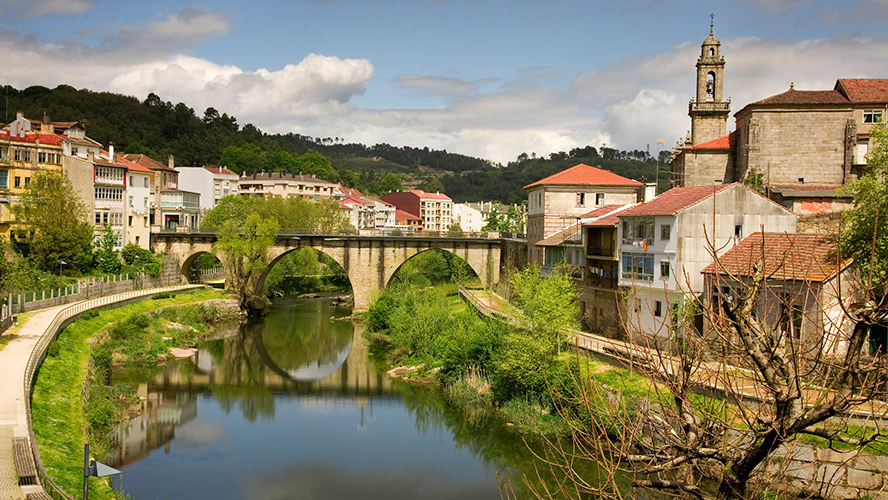
Carballiño
The history of this village can be traced back to the Neolithic Age but its symbol is the Temple of Veracruz, a structure dating from 1930 that was designed by architect Antonio Palacios and combines the Byzantine, Pre-Romanesque, Romanesque and Gothic styles. It perfectly contrasts with the monumental scale of 12th century Oseira Monastery, just a few kilometres away.
The parks and bridges spanning the Arenteiro River are also worth visiting for their impressive and mysterious natural settings.
Some of the biggest attractions in Carballiño are the Castro settlement of San Cibrao de Las, Pazo dos Quiroga, and the church of Santa Baia de Banga, a Romanesque building with a polychrome mural that has survived the church’s deterioration.
Carballiño is also famous for its thermal baths, perfect for a luxurious rest, and the octopus festival that is held here every August.
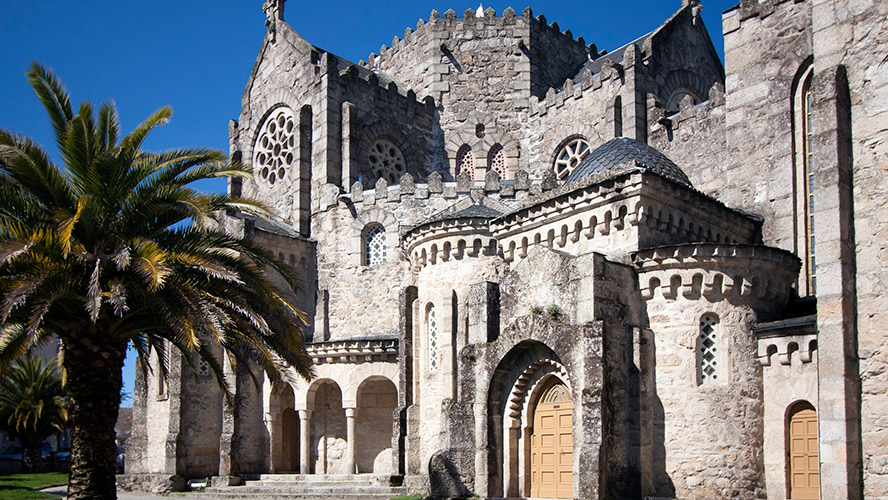
Vilanova dos Infantes
This region now belongs to Celanova but was independent until 1927. Its past is full of legends and historic feats… One tale is that it should have been called Vilanova de las Infantas after the seven sisters who came to live in this medieval village of porticoed houses, hórreos (typical granaries) and passageways.
The 10th century tower is one of its most famous buildings and is all that remains of the fortress that once protected the village.
The spiritual heart of the municipality and region is the sanctuary of the Virxe de Cristal, also known as A Pequeniña. In around 1650, a shepherd found a glass ball with a tiny statue of the Virgin Mary inside – no one knew where it came from and the villagers quickly decided it was a miracle. The church of San Salvador was built around the small ball and it contains a 12th century Romanesque Christ, one of the oldest in Galicia.
Pazos de Arenteiro
This village is the start of the Ribeiro region, famous across Spain for its wonderful wine. You can spot signs of its medieval and noble past throughout its cobbled streets, with examples of typical Galician architecture: stately homes, medieval bridges, a church and old convent belonging to the Order of Malta.
The wealthy members of society in Pazos de Arenteiro were mostly wine producing families who were required to pay taxes to the Knights of Malta for the vines. You can still see many stately homes here, such as Pazo de Laxas, Pazo de los Tizón, Pazo do Currelo, Pazo de Feixoo, Pazo de Cervela, Casa do Ouro, Casa Granxa do Mato and Casa de Arriba, among others.
We also recommend visiting the Romanesque church of San Salvador in the heart of Pazos de Arenteiro, where you can find out all about Captain Cachamuiña, who miraculously freed the village from the French in 1809.
Montederramo
The most important sight in Montederramo, which is 42 km from Ourense, is the 12th century monastery of Santa María de Montederramo, founded by Doña Teresa, the daughter of Alfonso VII. It was in this monastery that the area was first described as Ribeira Sacra in a written document.
The building has two cloisters, a chapel and a church that were restored and expanded between the 16th and 17th centuries, and it has an impressive square that makes this magical place even more majestic.
During the Ecclesiastical Confiscations of Mendizábal, the monastery passed into private hands and the monks’ cells still belong to a private individual.
If you have time, walk a short distance from the centre across a Roman bridge to enjoy a recreation area with a river beach by the Mao.
Celanova
This is one of the most beautiful and historical villages in Ourense. Its main attraction is the monastery of San Salvador; it was founded in 936 by San Rosendo but was expanded over the years thanks to donations from noble families. It enjoyed its period of greatest splendour in the 16th and 17th centuries when the church was built but was abandoned during the 19th century. The most interesting part of the complex is the old cloister, also known as El Procesional. Today, most of the monastery is used by the town council and a school, so it’s a good idea to join a guided tour to see it properly.
The Plaza Mayor and Plaza de Do Millo are near the centre of Celanova; they’re great places to stop for a break and a drink before visiting something very small yet very important nearby… The Mozarab chapel of San Miguel, the only one of its kind in Spain.
There are several literary routes that take you around the village and stop at the Fundación Curros Enríquez, the house where the family of poets once lived.
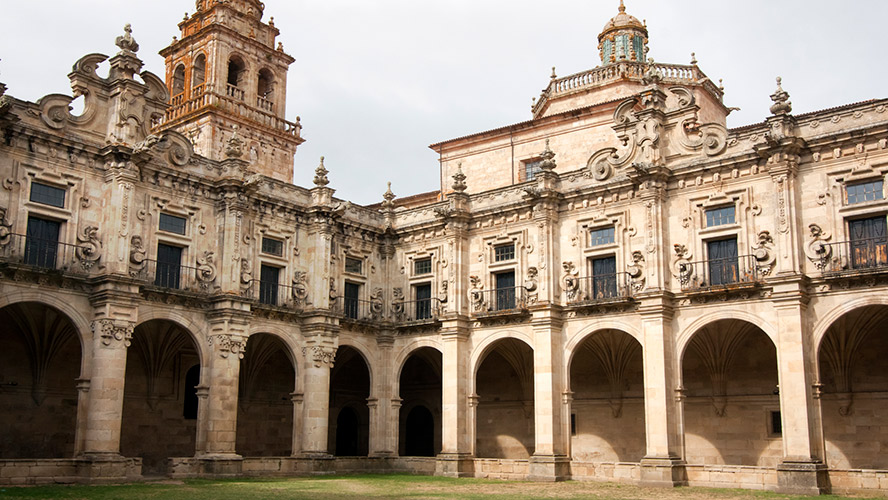
As Ermidas
The name of this village gives you a clue to its most important attraction. Legend tells that seven hermits created seven chapels here that eventually grew into the great sanctuary of Nosa Señora das Ermidas. It’s one of the most spectacular places in Ourense because this huge building is set right on the edge of the Bibei River gorge.
It’s said that, back in the 13th century, shepherds noticed that their flocks were cured when they grazed the slopes on this side. After searching the area, they found a cave that contained an image of the Virgin and Child. Another miracle occurred in the 17th century, this time involving the Bishop of Astorga; he commissioned the definitive building work on the sanctuary and it became a beautiful Baroque gem.
As Ermidas also has one of the most important Baroque Stations of the Cross in Europe, with life size images portraying the 14 scenes of the Passion of Christ.
While you’re here, make time to enjoy a stroll by the river and to admire the views from viewpoints over the Bibei River gorge, which is 500 m high in places.
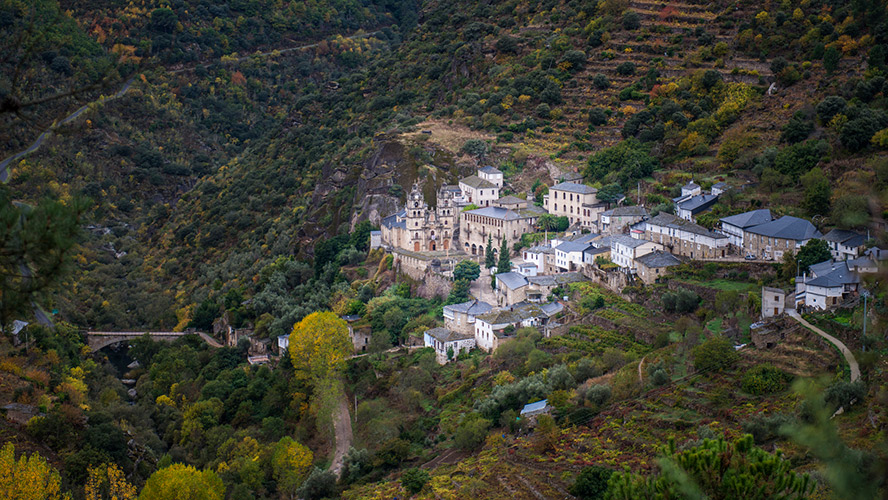
Where to stay in Ourense
One of the best places to stay is the four-star Barceló Ourense because it’s right in the city centre. Ourense is famous for its thermal waters and the city has a fresh and modern vibe, exceptional food and friendly people, all of which you’ll find when you stay at this hotel.
The Barceló Ourense is a great option because it has the largest guest rooms in the city; they’re designed with the B-room concept, so you’ll have a magnificent night’s sleep thanks to the pillow menu, rain showers, tea and coffee facilities and a particularly comfortable mattress.
The hotel also has a fitness room and sauna that are free for guests, and a healthy breakfast buffet. Drinks and snacks are available at the lobby bar.
If you’re on a business trip, the hotel has high speed Wi-Fi in every room and five, fully equipped meeting rooms that are suitable for every kind of event.
The Barceló Ourense is the ideal accommodation option for discovering a destination that surprises by day and night. Ourense is a wonderful place to visit for shopping, fine wine and to soak up the spirit of the famous Way of St James.




































































